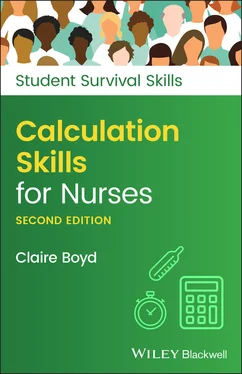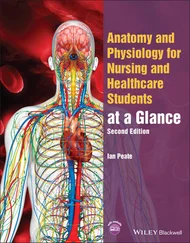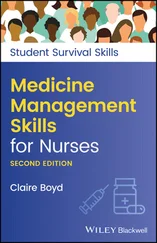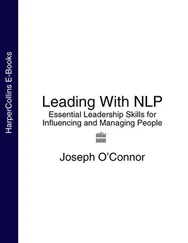Claire Boyd - Calculation Skills for Nurses
Здесь есть возможность читать онлайн «Claire Boyd - Calculation Skills for Nurses» — ознакомительный отрывок электронной книги совершенно бесплатно, а после прочтения отрывка купить полную версию. В некоторых случаях можно слушать аудио, скачать через торрент в формате fb2 и присутствует краткое содержание. Жанр: unrecognised, на английском языке. Описание произведения, (предисловие) а так же отзывы посетителей доступны на портале библиотеки ЛибКат.
- Название:Calculation Skills for Nurses
- Автор:
- Жанр:
- Год:неизвестен
- ISBN:нет данных
- Рейтинг книги:3 / 5. Голосов: 1
-
Избранное:Добавить в избранное
- Отзывы:
-
Ваша оценка:
- 60
- 1
- 2
- 3
- 4
- 5
Calculation Skills for Nurses: краткое содержание, описание и аннотация
Предлагаем к чтению аннотацию, описание, краткое содержание или предисловие (зависит от того, что написал сам автор книги «Calculation Skills for Nurses»). Если вы не нашли необходимую информацию о книге — напишите в комментариях, мы постараемся отыскать её.
Calculate the correct drug dosage every single time with help from this essential nursing guide Calculation Skills for Nurses
Calculation Skills for Nurses
Calculation Skills for Nurses — читать онлайн ознакомительный отрывок
Ниже представлен текст книги, разбитый по страницам. Система сохранения места последней прочитанной страницы, позволяет с удобством читать онлайн бесплатно книгу «Calculation Skills for Nurses», без необходимости каждый раз заново искать на чём Вы остановились. Поставьте закладку, и сможете в любой момент перейти на страницу, на которой закончили чтение.
Интервал:
Закладка:
Nursing has certainly evolved since the first addition of this book, not least the development of the Nursing Associate. You will see many Glossary terms, such as the following one explaining the role of these highly skilled healthcare professionals.
 Nursing Associate
Nursing Associate
The Nursing Associate is a member of the multidisciplinary nursing team in England that aims to bridge the gap between Health Care Assistants (HCA’s) and Registered Nurses (RN’s). Nursing Associates have been accepted onto the Nursing and Midwifery (NMC) register in England since January 2019.
You will also see directions to websites to assist the reader, at the bottom of the chapter pages, like these ones:
USEFUL WEB RESOURCES:
www.nmc.org.uk
www.skillsforhealth.org.uk
This book came into fruition by listening to student nurses – their wants and needs. This second edition has included a wider audience Nursing Associates, Overseas nurses and many more, and I have been grateful for the reviews from students and other readers who have given me suggestions for improvements for the new edition:
1 More practice activities – tick
2 Title change for more inclusivity – tick
3 More test questions – tick
4 More on looking at budgets and interpreting data – tick
5 Pointers to websites – tick
There are test questions for student nurses, newly qualified nurses, nurse associates, nursing assistants, paediatric nurses, midwives, mental health nurses, learning disabilities nurses, and the nurse prescriber (NMP).
 Nurse Prescriber
Nurse Prescriber
Post graduate nurses who have been licensed to issue medications to patients without a doctor being present or assessing the patient. Also known as Non‐Medical Prescribing Nurse (NMP)
There are also many more exercises and activities to get stuck into, and examples whereby you will see a box like this:
 Let me show you an example…
Let me show you an example…
1 If you buy a rooster for the purpose of laying eggs and you expect to get 3 eggs each day for breakfast, how many eggs will you have after three weeks?ANSWER: 3 × 7 = 213 × 7 = 213 × 7 = 21 TOTAL = 63 EggsWRONG!Roosters are male chickens and don’t lay eggs! D’oh!
OK, so that was a bit of fun! Don’t worry if you got fooled by this trick question, I did too when I first saw it. I just wanted to show you that we all make mistakes, but if we take our time, and work through any question methodically, we can work it out. After all, the majority of healthcare questions just rely on your ability to add, subtract, divideor multiply– yes, it really is that simple!
This book is divided into four parts:
Part 1: Diagnosis – includes assessing your own ability and basic revision. You can miss out these chapters if you feel you don’t need to work through them but this will give you a good grounding in basic maths, preparing you for the more complex questions.
Part 2: Understanding nursing calculations – this will show you what you need to know in the clinical area, such as working out drug dosages.
Part 3: Putting it all into practice – this will show you where the calculations we have worked through are applied in practice. It will show us that mathematics is used in many different areas in health care, including undertaking sample test questions, and working with budgets.
Part 4: Testing your knowledge and understanding – this is where we can monitor our increased abilities and showing us our progress.
I will show you how I approach maths problems: I believe firmly in using formulas for working out drug dosages, but I am aware that an understanding of how these formulas work must first be established, and a rough estimate of the correct answer should always be at the back of our minds. It is for this reason that I have produced the formulas in a handy format on the inside back cover for you to photocopy and laminate (for infection control, to be wiped clean) and keep in your pocket.
This book has been related to the NMC Standardsfor nursing and midwifery education (May 2018), Proficiency for registered nurses (May 2018), Proficiency for Nursing Associates (October 2018), Pre‐registration Nursing Associate programme (October 2018) and The Code – Professional Standards for practice and behaviour for nurses, midwives and nursing associates (October 2018) and the NMC Essential Skills Clusters. However, this book is designed to assist anyone working in the healthcare setting requiring mathematical assistance.
In short, this book is designed to instil confidence and competence in the area of calculations to healthcare professionals. It is designed to be used as a building block, a platform for the rest of your healthcare career.
Acknowledgements
I, along with the publishers, would particularly like to thank all the nursing students who helped develop this book into what it is. Also, to the group of overseas nurses I met this year who told me that this series of books was on their reading list and they particularly liked the humour in it – thank you. Also, the student nurses who gave direction on what they also wanted included in this book and the other student healthcare professionals asking for more questions to do with their specific branch of healthcare – the Midwives, Paediatric Nurses and Mental Health Nurses, etc. – your wish is our command! Also, the Nursing Associates who wanted a book to bridge the gap between Nursing Assistants and Registered Nurses – again your wish is granted!
I would also like to extend my thanks to Magenta Styles (Associate Editorial Director) for her guidance and direction and to the team at Wiley‐Blackwell for their support.
I dedicate this book to my loving family: husband Rob (for the use of his photographs), and to my grandson Owen who likes to play our favourite maths game with me – taking all the chocolates out of the tin and laying them out and counting them and making a couple disappear each time. Adding and subtraction is so much fun, Yum! Also, to baby Rhys who is right that Granny’s notes are much more fun when scrunched up to make snowballs out of! Also, thanks to Simon, Louise and David for all their assistance in helping to develop the book series.
Latin Abbreviations
Here is a list of some Latin abbreviations that you may see on prescription forms:
| AC | ante cibum (before food) |
| BD | bis die (twice daily) |
| OD | omni die (every day) |
| OM | omni mane (every morning) |
| ON | omni nocte (every night) |
| PC | post cibum (after food) |
| PRN | pro re nata (when required) |
| QDS | quater die sumendus (to be taken four times daily) |
| QQH | quarta quaque hora (every 4 hours) |
| STAT | immediately |
| TDS | ter die sumendus (to be taken three times daily) |
| TID | ter in die (three times daily) |
Part 1 DIAGNOSIS
Интервал:
Закладка:
Похожие книги на «Calculation Skills for Nurses»
Представляем Вашему вниманию похожие книги на «Calculation Skills for Nurses» списком для выбора. Мы отобрали схожую по названию и смыслу литературу в надежде предоставить читателям больше вариантов отыскать новые, интересные, ещё непрочитанные произведения.
Обсуждение, отзывы о книге «Calculation Skills for Nurses» и просто собственные мнения читателей. Оставьте ваши комментарии, напишите, что Вы думаете о произведении, его смысле или главных героях. Укажите что конкретно понравилось, а что нет, и почему Вы так считаете.












